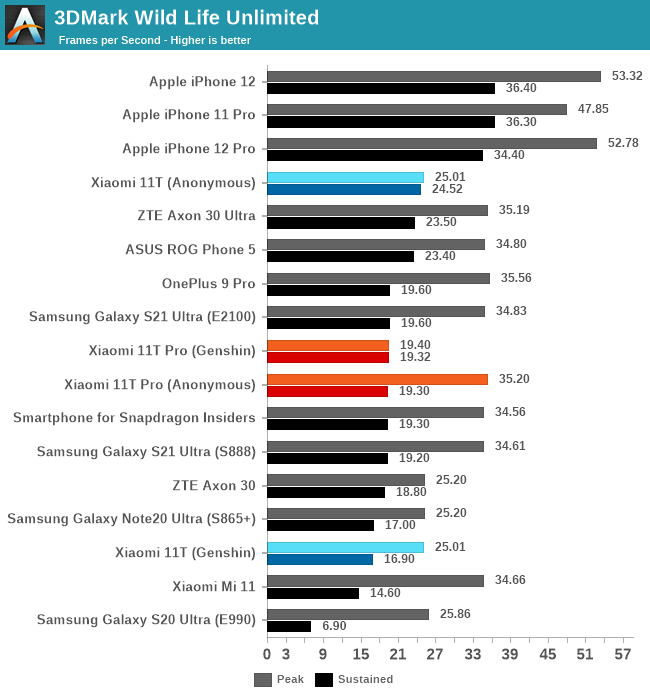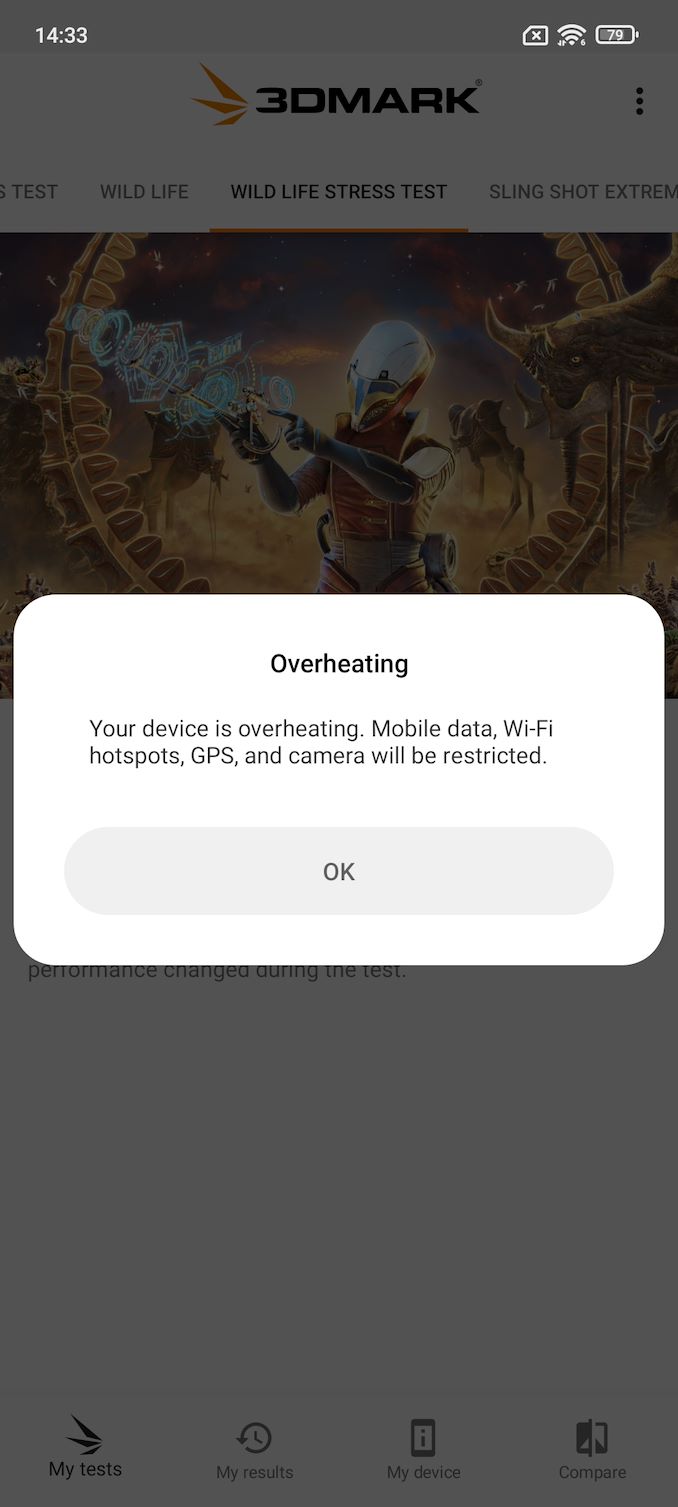The Xiaomi 11T & 11T Pro Review: Two Chips, With a Battery Focus
by Andrei Frumusanu on September 15, 2021 9:00 AM EST- Posted in
- Mobile
- Smartphones
- Xiaomi
- Xiaomi 11T
- Xiaomi 11T Pro
GPU Performance - More "Optimisations"
On the GPU side of things, it’s again a very interesting to match up the Snapdragon 888 versus the Dimensity 1200. The Snapdragon should dominate in peak performance, however sustained is another question.
Unfortunately, the 11T Pro here is again a Snapdragon Xiaomi device like many that we’ve seen in the past – the issue here being is that the phone just outright doesn’t throttle at all. In anonymous applications, the phone will go full power no matter the temperature until at some point it’ll give out an overheating warning.
The MediaTek 11T also didn’t throttle at all, and although the phone reached 47°C at least it didn’t give off any overheating warning.
Lately I’ve been spoofing our workloads as popular games, specifically Genshin Impact, given it’s the most popular and most demanding real world gaming title out there. Benchmarking the game itself is hard because of the dynamic resolution and differing graphics settings depending on devices, but spoofing a standardised workload as the game work well to showcase representative gaming performance.

Unfortunately, this experiment here showcases Xiaomi’s shenanigans:
First off with the MediaTek 11T: the anonymous test doesn’t throttle at all and peak and sustained performance figures are essentially the same, with the chip actually faring quite well here in sustained performance, not accounting for the hot phone.
In the Genshin spoofed test, the device has drastically lower thermal behaviour, and throttles at lot quicker to lower performance states. He phone was generally only 39°C warm which was very good.
On the Snapdragon 11T Pro, there’s quite the shocking revelation; the phone is outright capping peak performance, gutting it to otherwise the sustained performance levels of the anonymous version (before the overheating warning).
Thermals of the phone here are excellent at only around 37°C peak skin temperatures. Generally, the prolonged gaming performance here isn’t changed as the both end up at the same level.
The problem with this “optimisation” is of course that it’s completely misleading the benchmarks. If real games are actually severely limited in GPU frequency and performance, then this should also be represented in benchmarks for transparency.
I’m very exhausted by these opaque mechanisms, because most other reviewers will likely not catch them, which is likely Xiaomi’s goal. It’s a crap industry behaviour that needs to be abolished.
I’m skipping over the rest of the benchmarks here as it’s not even worth showcasing.











41 Comments
View All Comments
mingogomes - Wednesday, September 15, 2021 - link
Hey Andrei,On your battery test of PCMark, can you tell me what brightness settings you were using?
Max, 50% or low?
Thanks
5j3rul3 - Wednesday, September 15, 2021 - link
Hope there's more info and review about those extremely fast cahrge system, such as:Oppo
125W / 65W
40W / 30W WL
vivo (iQOO)
120W / 55W / 44W
50W WL
Xiaomi (RedMi, POCO, Blackshark) 120W / 67W / 65W / 50W
80W / 67W / 50W WL
Lenovo
100W
RedMagic
100W / 55W
Qualcomm
100W
HUAWEI
66W / 40W
66W / 40W / 27W WL
RealMe
65W
50W WL
5j3rul3 - Wednesday, September 15, 2021 - link
Adjustment:OnePlus
65W
50W WL
Honor
100W / 66W
50W WL
RedMagic
120W / 100W
ASUS
65W
5j3rul3 - Wednesday, September 15, 2021 - link
Is there any Mi 11T series' camera review?Or just wait iPhone 13 and other smartphones to have a 21H2 smartphone cam battle?
Andrei Frumusanu - Wednesday, September 15, 2021 - link
I didn't have time to do camera, in general expect lacklustre results worse than the Mi 11.Wereweeb - Wednesday, September 15, 2021 - link
IMO a 108MP camera that gets binned down to 27MP is no better than a 48MP camera that gets binned down to 12MP (8.3MP for 4K image + EIS margin). Massive waste of sensor area.(And no, it's not for 8K photo/video, that would require a sensor that gets resolved to at least 33MP)
Plumplum - Monday, September 20, 2021 - link
It's nona-binning...108MP to 12MP...With binning, pixel's size is 2.1microns (3x0.7)
On 48MP, pixel's size is 1.6microns (2x0.8)
Light received by pixel is (2.1/1.6)^2=1.72.
Pixels received +72% light compared to 48MP
I use 50MP IMX766 on Nord 2. Binned Pixel's size is 2.0microns...in low light conditions, it has nothing to do with most 48MP sensors.
Lack of OIS is the weakness on these devices, not sensor.
pfactor - Wednesday, September 15, 2021 - link
From the label, it looks like this charger only achieves 120w output when it is connected to a 220~240V AC supply. (Otherwise, the max output at when connected to 120V AC is only 96W) Was this tested in the US or in Europe?The output rating on the label should be a true output rating, and not a measurement of input power consumed.
ArcadeEngineer - Thursday, September 16, 2021 - link
Andrei lives in Luxembourg, so 230v.Andrei Frumusanu - Thursday, September 16, 2021 - link
I measured 115W on the AC side.